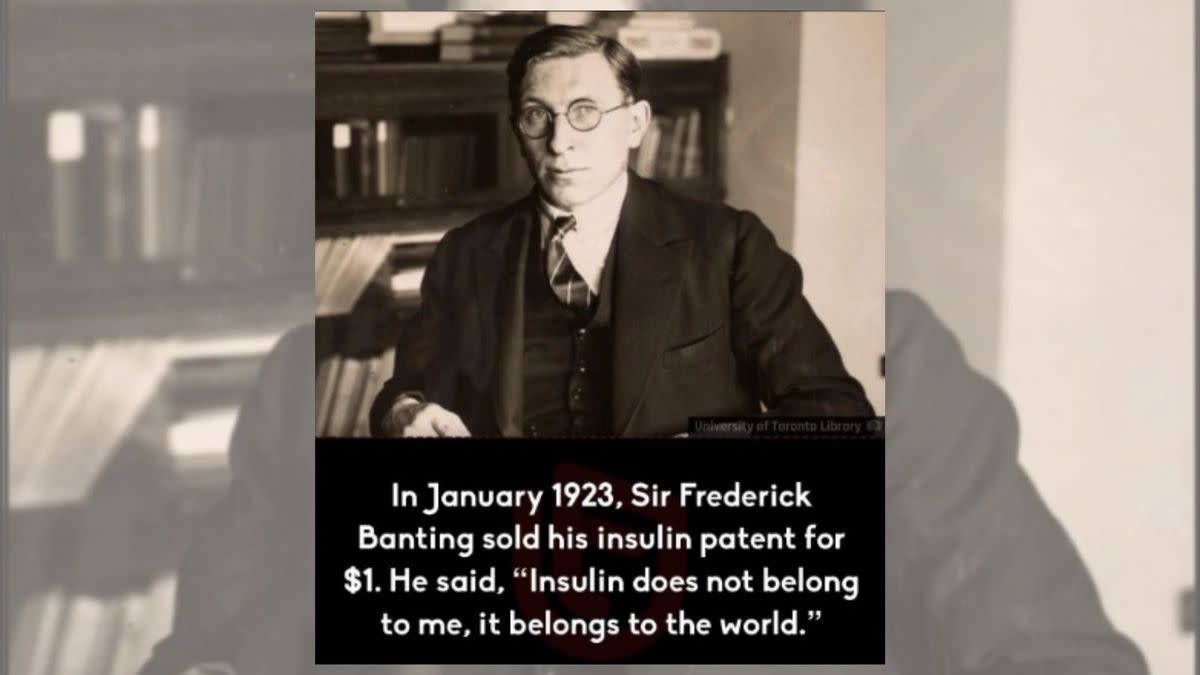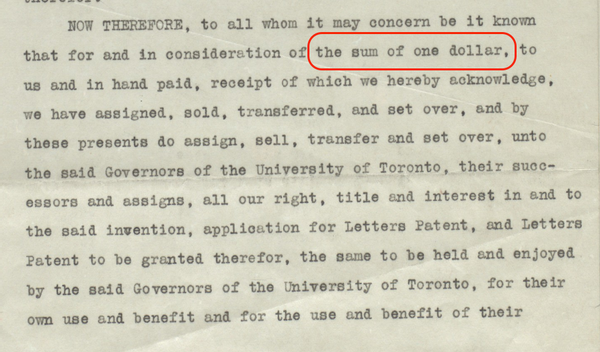Fact Check: About the Claim That a Scientist Sold His Insulin Patent for $1, Saying 'It Belongs to the World'

Claim:
In 1923, scientist Frederick Banting sold his insulin patent for $1, saying, “Insulin does not belong to me, it belongs to the world.”
Rating:
What's True:
Canadian scientist Frederick Banting and his co-discoverers of insulin sold their patent to the University of Toronto for $1 in a deal that was finalized in 1923.
What's False:
However, there is no evidence that Banting ever said “Insulin does not belong to me, it belongs to the world.”
On June 12, 2024, a Reddit post on the r/BeAmazed subreddit claimed that, in January 1923, Frederick Banting sold his insulin patent for $1, saying, "Insulin does not belong to me, it belongs to the world." As of this writing, the post has received around 23,000 upvotes.
The alleged quote has circulated widely for years. The World Health Organization's Facebook page shared an image featuring it on June 11, 2024. U.S. Rep. Ro Khanna, a California Democrat, posted an abridged version on X in 2019. The quote also appears in a number of published books and scholarly journal articles.
Despite the quote's prevalence across different types of media, Snopes found no evidence that Banting, the Canadian scientist who won a Nobel Prize for discovering insulin, ever said it. However, it is true that Banting and two colleagues sold their patent for the lifesaving drug for just $1 in 1923. As such, we rate this claim a "Mixture" of truth and falsity.
The original source for the quote appears to be a children's biography of Banting titled "The Discoverer of Insulin: Dr. Frederick Banting," written by I.E. Levine and published in 1959, 18 years after Banting died in a plane crash. Neither the quote nor any variation thereof appears in any of the sources cited in the bibliography at the end of the book.
The quote also does not appear in any of the biographies of Banting written for adults, such as Michael Bliss's acclaimed "Banting: A Biography," or in any legitimate media coverage of Banting from either before or after his death. As such, the likeliest explanation for the origin of the quote is that Levine, the author of biographical books for children, used artistic license to imagine something Banting might have said.
The details of Banting's sale of the patent for insulin, on the other hand, are well-documented and can be substantiated.
The patent's buyer, the University of Toronto, has made digital scans of the original patent assignment document available online. The amount the University of Toronto paid Banting and his colleagues Charles Herbert Best and James Bertram Collip for the patent, $1, is clearly noted on the document's first full page.

(University of Toronto Libraries)
Eagle-eyed readers might note that the assignment document is dated Dec. 19, 1922, not 1923. The document's cover sheet explains why 1923 is the year typically given for the sale: The transfer of the patent from Banting and his colleagues to the University of Toronto was not formally recorded in the Ottawa Patent and Copyright Office until Jan. 1, 1923, so the patent technically remained in the three scientists' names until then.
According to the Bank of Canada's Inflation Calculator, that $1 in 1923 would be worth around 17.46 Canadian dollars ($12.70) in 2024 — a substantial increase in terms of percent change, but still a remarkably low price for the patent for a drug of critical importance.
What about the reason Banting and his colleagues decided to sell the insulin patent for so little money? In an article published in the Journal of Clinical Investigation in 2021, diabetes researchers Gary F. Lewis and Patricia L. Brubaker explained the rationale for the sale, which was more complicated than the simple altruism suggested by memes about Banting.
In short, the sale was part of a larger agreement between the scientists, the University of Toronto and U.S. drug company Eli Lilly intended to ramp up production of the drug in order to meet demand as quickly as possible. As part of the terms of the agreement, Eli Lilly committed to licensing insulin from the University of Toronto and manufacturing and distributing the drug free of charge to certain hospitals for one year.
After that year, Eli Lilly was left with an effective monopoly on U.S. rights to the drug, which it was legally free to profit from. According to Lewis and Brubaker, in the first year the company was allowed to charge for the drug, Eli Lilly brought in more than $1 million, equivalent to around $18.4 million in 2024, from insulin sales alone. In other words, although Banting did not make a direct profit from insulin sales, the drug became highly profitable for Eli Lilly as a result of the terms of the sale.
Eli Lilly remains one of the three main suppliers of insulin in the U.S., with the others being Sanofi and Novo Nordisk. Following price caps announced in 2023, Eli Lilly and Sanofi now charge a maximum out-of-pocket price of $35 a month for the most widely prescribed form of insulin. Novo Nordisk has also implemented programs to reduce out-of-pocket costs for diabetes patients.
Before the implementation of U.S. price caps, however, American insulin prices far surpassed those in other countries. In a study comparing insulin prices in the U.S. with those in other countries, the RAND Corp. found that in October 2019 the average U.S. price per standard unit of the drug was $98.70, compared with $7.52 in the U.K., $9.08 in France and $12 in Canada.
In summary, it is true that Banting and his insulin co-discoverers sold their patent for the drug to the University of Toronto for $1 in a sale that was finalized in 1923. However, there is no evidence that Banting ever said "Insulin does not belong to me, it belongs to the world," despite the widespread appearance of the quote on social media and elsewhere. Additionally, although the 1923 sale of the insulin patent significantly sped up the availability of the drug worldwide, it did not directly result in universally affordable insulin prices.
Sources:
Assignment to the Governors of the University of Toronto. Collections U of T. collections.library.utoronto.ca, https://collections.library.utoronto.ca/view/insulin:Q10013. Accessed 13 June 2024.
Bliss, Michael. Banting: A Biography. University of Toronto Press, 1992.
Diem, P., et al. "The Discovery of Insulin." Diabetes Epidemiology and Management, vol. 5, Jan. 2022, p. 100049. ScienceDirect, https://doi.org/10.1016/j.deman.2021.100049.
"Drugmaker Eli Lilly Caps the Cost of Insulin at $35 a Month, Bringing Relief for Millions." NBC News, 1 Mar. 2023, https://www.nbcnews.com/health/health-news/eli-lilly-caps-cost-insulin-35-month-rcna72713.
Friedman, Lester D., and Therese Jones. Routledge Handbook of Health and Media. Taylor & Francis, 2022.
Inflation Calculator. https://www.bankofcanada.ca/rates/related/inflation-calculator/. Accessed 13 June 2024.
Inflation Calculator | Find US Dollar's Value From 1913-2024. 12 June 2024, https://www.usinflationcalculator.com/.
Levine, I. E. (Israel E. ). The Discoverer of Insulin: Dr. Frederick Banting. New York, J. Messner, 1959. Internet Archive, http://archive.org/details/discovererofinsu00levi.
Lewis, Gary F., and Patricia L. Brubaker. "The Discovery of Insulin Revisited: Lessons for the Modern Era." The Journal of Clinical Investigation, vol. 131, no. 1, p. e142239. PubMed Central, https://doi.org/10.1172/JCI142239. Accessed 13 June 2024.
Luhby, Tami. "More Americans Can Now Get Insulin for $35 | CNN Politics." CNN, 1 Jan. 2024, https://www.cnn.com/2024/01/01/politics/insulin-price-cap/index.html.
---. "Novo Nordisk Becomes Latest to Announce It Is Cutting Insulin Prices by up to 75%." CNN, 14 Mar. 2023, https://www.cnn.com/2023/03/14/health/novo-nordisk-insulin-prices/index.html.
Mulcahy, Andrew W., et al. Comparing Insulin Prices in the United States to Other Countries: Results from a Price Index Analysis. RAND Corporation, 6 Oct. 2020. www.rand.org, https://www.rand.org/pubs/research_reports/RRA788-1.html.
"The Nobel Prize in Physiology or Medicine 1923." NobelPrize.Org, https://www.nobelprize.org/prizes/medicine/1923/banting/facts/. Accessed 13 June 2024.



